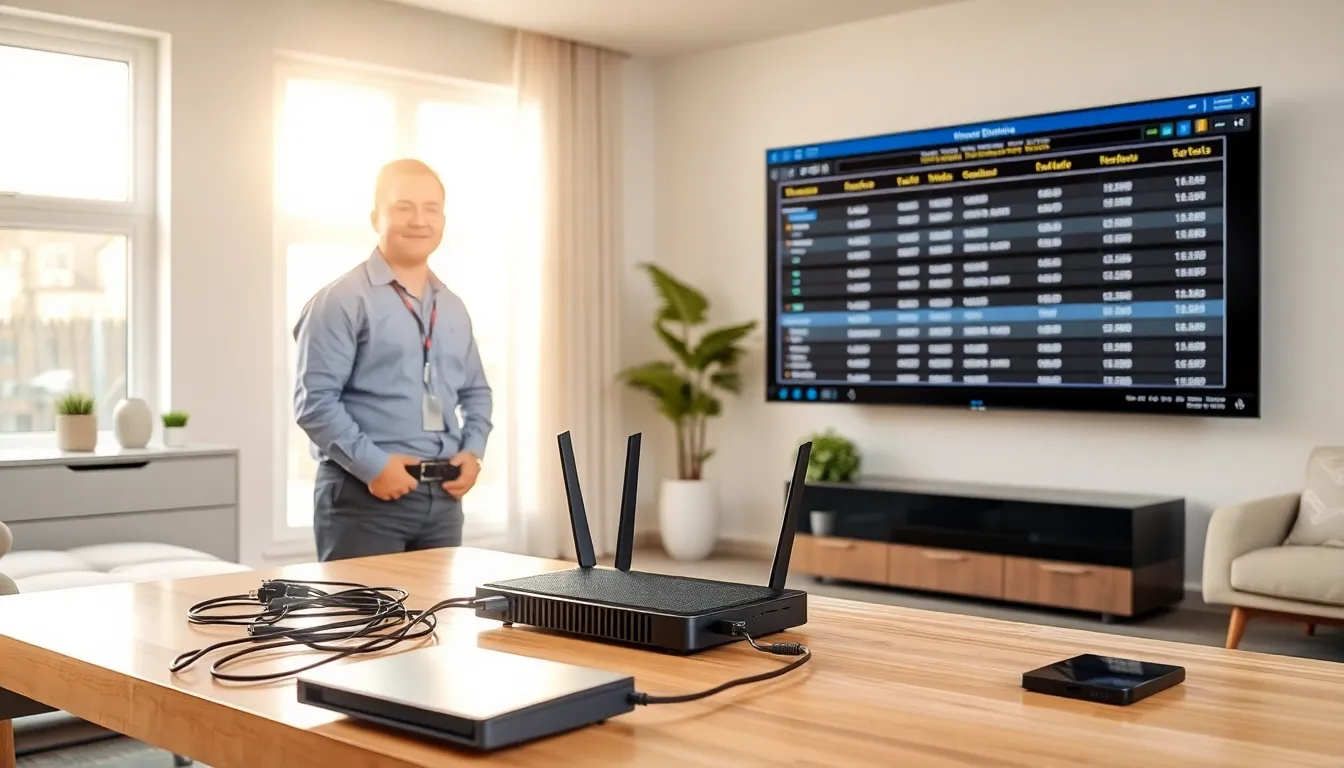In today’s world, where buffering videos and dropped connections can cause anything from mild annoyance to full-blown chaos, understanding home networking installation services becomes essential. Picture this: it’s a lazy Sunday, popcorn in hand, and your favorite show is about to stream. But wait, your internet decides to play hide-and-seek. If you find yourself in this scenario more often than you’d like, it might be time to consider upgrading your home network. Just like a professional chef wouldn’t settle for anything less than the best kitchen tools, you shouldn’t compromise on your home networking. With a dash of humor and a sprinkle of knowledge, let’s investigate into the art and science of creating a robust home network that keeps your devices happy and your streaming seamless.
Table of Contents
ToggleUnderstanding Home Networking

Home networking, in simple terms, refers to the connection of multiple devices within a home to a common network. Whether it’s smartphones, laptops, smart TVs, or gaming consoles, all these interconnected gadgets rely on a stable network to communicate with each other and access the internet. Imagine trying to juggle multiple tasks without a reliable assistant, frustrating, right? A properly set up home network acts as that reliable assistant, facilitating smooth communication among all devices and ensuring that everyone in the household can stream, game, and browse without a hitch.
But wait, it’s not just about connection: understanding the underlying technologies can give you an edge. Home networks typically use various protocols like Wi-Fi, Ethernet, and sometimes even powerline networking. While Wi-Fi might be your mainstay, Ethernet is the trusty sidekick that provides wired reliability. When one device experiences a hiccup, you’ll be thankful for the other support, seamlessly keeping your digital life afloat.
Types of Home Networks
When it comes to networks, variety is the spice of life. Here are the main types of home networks you might encounter:
- Wired Networks: These networks use Ethernet cables to connect devices. They are known for their speed and reliability, making them ideal for activities like gaming or streaming.
- Wireless Networks: Wi-Fi networks are the heroes of convenience, allowing devices to connect without pesky cords. While they offer flexibility, the trade-off can sometimes be connectivity issues in larger homes.
- Mesh Networks: Enter the mesh network, this emerging star uses multiple nodes spread throughout your home for a more comprehensive coverage. It’s perfect for those large spaces where traditional Wi-Fi struggles to keep up.
- Hybrid Networks: Combining both wired and wireless elements, hybrid networks aim to take the best of both worlds. This setup is particularly useful for households with high demands for both speed and mobility.
Choosing the right type can make all the difference. Consider your browsing habits, the size of your home, and how many devices you plan to connect.
Benefits of Professional Installation
Thinking about a DIY network installation? You aren’t alone. Many brave souls venture into this territory only to find themselves knee-deep in manuals and cables. Here’s where professional installation services come to the rescue.
- Expertise: Trained professionals understand the intricacies of home networking. They know which equipment will work best for your specific needs and how to optimize performance.
- Time-Saving: Setting up a network can be time-consuming. By hiring experts, you can free up your schedule for more important matters, like pondering what to binge-watch next.
- Troubleshooting: Ever tried fixing a network issue only to find it spiraling into a million other problems? Professionals come equipped with the tools and knowledge to resolve issues swiftly.
- Future-Proofing: Technology is always evolving, and professional installers keep pace with the latest trends and innovations. They can set up frameworks that adapt as your needs grow.
Investing in professional installation isn’t just about connection: it can save you stress in the long run.
Choosing the Right Home Networking Installation Service
Selecting the right home networking installation service can feel akin to choosing a dentist, personal recommendations go a long way, but there’s also a lot to consider. Here are key factors to keep in mind:
- Experience: Look for companies with a proven track record. It’s advisable to opt for those who can showcase positive user reviews and successful installations.
- Certifications: Many services employ certified technicians. A certified installer has undergone training to keep your installation up to standard.
- Customer Support: Good customer service can make or break your experience. Ensure they offer ongoing support and are responsive to your queries.
- Custom Solutions: Every home is unique. Opt for services that provide tailored solutions based on your specific needs and preferences.
Taking the time to evaluate these factors ensures you partner with a service that aligns with your needs, eventually leading to a more efficient home network.
The Installation Process: What to Expect
Thinking about what happens during a professional network installation? It’s essential to set expectations. Here’s a step-by-step breakdown of a typical installation process:
- Consultation: Technicians will arrive and discuss your specific needs. This conversation covers your internet usage habits, preferred devices, and any problem areas in your home that require special attention.
- Site Survey: Once they understand your requirements, they conduct a site survey to determine potential obstacles affecting network performance, like thick walls or interference from appliances.
- Equipment Setup: Technicians will install routers, switches, and any other necessary hardware. They’ll ensure everything is positioned ideally to maximize coverage.
- Configuration: This step involves configuring network settings and securing your network to prevent unauthorized access. It’s the difference between an open door and a locked vault.
- Testing: After installation, a thorough testing phase is crucial to ensure everything runs smoothly. Technicians will analyze speed, connection quality, and coverage areas.
By staying informed about the installation process, customers can feel empowered and in control throughout the experience.
Ensuring Network Security
In an era where online security breaches make headlines, ensuring your home network is secure is paramount. A few proactive measures can go a long way:
- Change Default Credentials: Many devices come with default usernames and passwords that are easy for cybercriminals to exploit. Changing these credentials reduces vulnerability significantly.
- Use Strong Passwords: Aim for complex and lengthy passwords. A mix of letters, numbers, and special characters can make unauthorized access a challenging job for would-be intruders.
- Enable Network Encryption: Setting up your network with strong encryption protocols, such as WPA3, is like putting your network in a protective bubble.
- Regular Updates: Keeping your network devices updated is crucial. Security patches are released periodically, which help to close potential loopholes.
By prioritizing security, homeowners can enjoy the benefits of their networks without the nagging worry of potential threats lurking in the virtual shadows.

